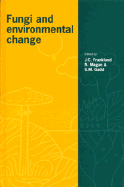Book contents
- Frontmatter
- Contents
- List of contributors
- Preface
- 1 Effects of climate change on fungal diseases of trees
- 2 Effects of climate change on Fusarium foot rot of winter wheat in the United Kingdom
- 3 Effects of UV-B radiation (280–320 nm) on foliar saprotrophs and pathogens
- 4 Implications of global warming and rising sea-levels for macrofungi in UK dune systems
- 5 Red Data Lists and decline in fruiting of macromycetes in relation to pollution and loss of habitat
- 6 Effects of dry-deposited SO2 and sulphite on saprotrophic fungi and decomposition of tree leaf litter
- 7 Effects of atmospheric pollutants on phyllosphere and endophytic fungi
- 8 Influences of acid mist and ozone on the fluorescein diacetate activity of leaf litter
- 9 Mycorrhizas and environmental stress
- 10 Myccorhizas, succession, and the rehabilitation of deforested lands in the humid tropics
- 11 Potential effects on the soil mycoflora of changes in the UK agricultural policy for upland grasslands
- 12 Uptake and immobilization of caesium in UK grassland and forest soils by fungi, following the Chernobyl accident
- 13 Effects of pollutants on aquatic hyphomycetes colonizing leaf material in freshwaters
- 14 Fungi and salt stress
- 15 Fungal sequestration, mobilization and transformation of metals and metalloids
- 16 Urban, industrial and agricultural effects on lichens
- 17 Fungal interactions with metals and radionuclides for environmental bioremediation
- 18 Impact of genetically-modified microorganisms on the terrestrial microbiota including fungi
- 19 Has chaos theory a place in environmental mycology?
- Index of generic and specific names
- Subject index
4 - Implications of global warming and rising sea-levels for macrofungi in UK dune systems
Published online by Cambridge University Press: 05 November 2011
- Frontmatter
- Contents
- List of contributors
- Preface
- 1 Effects of climate change on fungal diseases of trees
- 2 Effects of climate change on Fusarium foot rot of winter wheat in the United Kingdom
- 3 Effects of UV-B radiation (280–320 nm) on foliar saprotrophs and pathogens
- 4 Implications of global warming and rising sea-levels for macrofungi in UK dune systems
- 5 Red Data Lists and decline in fruiting of macromycetes in relation to pollution and loss of habitat
- 6 Effects of dry-deposited SO2 and sulphite on saprotrophic fungi and decomposition of tree leaf litter
- 7 Effects of atmospheric pollutants on phyllosphere and endophytic fungi
- 8 Influences of acid mist and ozone on the fluorescein diacetate activity of leaf litter
- 9 Mycorrhizas and environmental stress
- 10 Myccorhizas, succession, and the rehabilitation of deforested lands in the humid tropics
- 11 Potential effects on the soil mycoflora of changes in the UK agricultural policy for upland grasslands
- 12 Uptake and immobilization of caesium in UK grassland and forest soils by fungi, following the Chernobyl accident
- 13 Effects of pollutants on aquatic hyphomycetes colonizing leaf material in freshwaters
- 14 Fungi and salt stress
- 15 Fungal sequestration, mobilization and transformation of metals and metalloids
- 16 Urban, industrial and agricultural effects on lichens
- 17 Fungal interactions with metals and radionuclides for environmental bioremediation
- 18 Impact of genetically-modified microorganisms on the terrestrial microbiota including fungi
- 19 Has chaos theory a place in environmental mycology?
- Index of generic and specific names
- Subject index
Summary
Introduction
The effects of environmental change on the sand-dune ecosystem do not have to be considered hypothetically; they can be observed. Sand dunes are, by definition, dynamic systems, being created, shaped, modified, sustained or eroded by continual changes in a wide range of abiotic and biotic environmental factors. The fungi which inhabit this coastal ecosystem are subject to, and are part of, those same changes. Frankland (1981) stated that ‘community life for a fungus is dynamic’. This is nowhere more true than in sand-dune habitats where the combination of a dynamic biological organism functioning in a dynamic resource system constitutes a veritable dynamic duo, capable of long-term survival and viability.
Climatic background
Sea levels along the British coastline have been fluctuating for thousands of years. Around 12000 B.P. they were 50 m lower on the Welsh coast (Savidge, 1983). Some 5000 years ago it would have been possible to cross the Straits of Dover from England to France on dry land (Zuckerman, 1986). Mean global sea-level has risen by about 10–15cm during the twentieth century (Robin, 1986). Yet sand dunes in various stages of development still occupy 9% of the coastline of mainland Britain (Ranwell & Boor, 1986), in the form of spit dunes, bay dunes, hindshore dunes, prograding dunes or offshore island dunes. They provide all the classic dune habitats for fungi: yellow and grey dune, dune slack, dune grassland, dune scrub and dune heath (Fig. 4.1).
- Type
- Chapter
- Information
- Fungi and Environmental Change , pp. 51 - 60Publisher: Cambridge University PressPrint publication year: 1996

